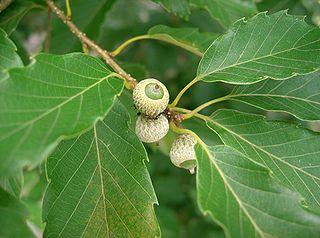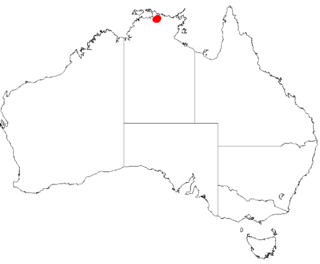A bridle path is a path or trail for horses.

The ora serrata is the serrated junction between the choroid and the ciliary body. This junction marks the transition from the simple, non-photosensitive area of the ciliary body to the complex, multi-layered, photosensitive region of the retina. The pigmented layer is continuous over choroid, ciliary body and iris while the nervous layer terminates just before the ciliary body. This point is the ora serrata. In this region the pigmented epithelium of the retina transitions into the outer pigmented epithelium of the ciliary body and the inner portion of the retina transitions into the non-pigmented epithelium of the cilia. In animals in which the region does not have a serrated appearance, it is called the ora ciliaris retinae.

Aristotelia serrata, commonly known as wineberry or in the Māori language makomako or just mako, is a small tree in the family Elaeocarpaceae, in the genus Aristotelia, found in the North Island, South Island and Stewart Island of New Zealand.

Lepidaspis serrata is an extinct heterostracan jawless fish from Early Devonian Canada. Its scientific name refers to the fact that the armor is composed of hundreds of tiny scales with serrated edges.

Banksia serrata, commonly known as the saw banksia, the old man banksia, the saw-tooth banksia or the red honeysuckle and as wiriyagan by the Cadigal people, is a species of woody shrub or tree of the genus Banksia, in the family Proteaceae. Native to the east coast of Australia, it is found from Queensland to Victoria with outlying populations on Tasmania and Flinders Island. Commonly growing as a gnarled tree up to 16 m (50 ft) in height, it can be much smaller in more exposed areas. This Banksia species has wrinkled grey bark, shiny dark green serrated leaves and large yellow or greyish-yellow flower spikes appearing over summer. The flower spikes, or inflorescences, turn grey as they age and pollinated flowers develop into large, grey, woody seed pods called follicles.
Bridle usually refers to headgear worn by horses and other animals that are ridden or driven.

Euphorbia serrata is a species of spurge known by the common names serrated spurge and sawtooth spurge. It is native to Europe but it is present elsewhere as a weedy introduced species. This is a perennial herb growing anywhere from 20 centimetres to about half a metre in height. The leaves are long and very narrow on most of the plant, with more oval-shaped leaves toward the tips of the stems. They are finely toothed. At the ends of the branches are inflorescences of tiny flowers. The fruit is a spherical capsule about half a centimetre wide containing tiny gray seeds.

Priscacara, is a genus of extinct temperate bass described from Early to Middle Eocene fossils. It is characterized by a sunfish-like body and its stout dorsal and anal spines. The genus is best known from the Green River Formation of Wyoming, Utah and Colorado. Mass deaths of Priscacara suggest it formed schools.

Hydrangea serrata is a species of flowering plant in the family Hydrangeaceae, native to mountainous regions of Korea and Japan. Common names include mountain hydrangea and tea of heaven. Growing to 1.2 m (4 ft) tall and broad, it is a deciduous shrub with oval leaves and panicles of blue and pink flowers in summer and autumn (fall). It is widely cultivated as an attractive ornamental shrub throughout the world in areas with suitable climate and soil.

Engelhardia serrata is a species of tree in the family Juglandaceae. It is native to southwest China, Indo-China, Indonesia, and the Philippines.
Pseudopostega serrata is a moth of the family Opostegidae. It is widespread in Costa Rica up to elevations of 1,520 meters. It has also been recorded from Ecuador and southern Panama.

Rotheca serrata, commonly known as the blue fountain bush, the blue-flowered glory tree or the beetle killer, is a species of flowering plants in the family Lamiaceae. It is native to India, Sri Lanka and Malaysia.

Nisista serrata, the serrated crest-moth, is a species of moth of the family Geometridae first described by Francis Walker in 1857. It is found in Australia, including Tasmania, Victoria and South Australia.

Azara serrata, the saw-toothed azara, is a species of flowering plant in the family Salicaceae, native to Chile. It is an evergreen shrub growing to 4 m (13 ft), with glossy serrated leaves and clusters of scented yellow flowers in summer. In temperate regions it requires a sheltered position.

Quercus serrata, the jolcham oak, is an East Asian species of tree in the beech family. It is native to China, Taiwan, Japan, and Korea.

Zelkova serrata is a species of the genus Zelkova native to Japan, Korea, eastern China and Taiwan. It is often grown as an ornamental tree, and used in bonsai. There are two varieties, Zelkova serrata var. serrata in Japan and mainland eastern Asia, and Zelkova serrata var. tarokoensis (Hayata) Li on Taiwan which differs from the type in its smaller leaves with less deeply cut serration on the margins.

Gazania serrata is a species of flowering plant in the family Asteraceae, native to the Northern Cape and Western Cape provinces, South Africa.

Pityrodia serrata is a species of flowering plant in the mint family Lamiaceae and is endemic to the northern part of the Northern Territory. It is an erect shrub with sharply-pointed, egg-shaped leaves with serrated edges, and off-white, bell-shaped flowers streaked with purple.














